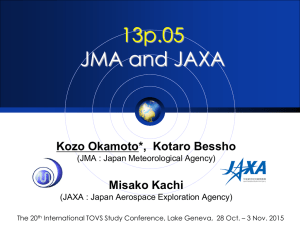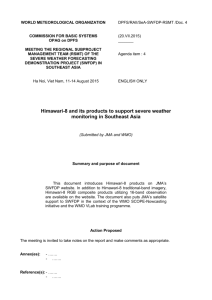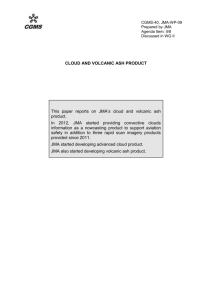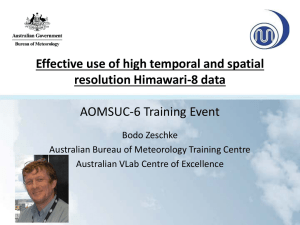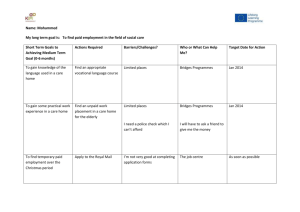Preparation FOR NEW products Expected
advertisement
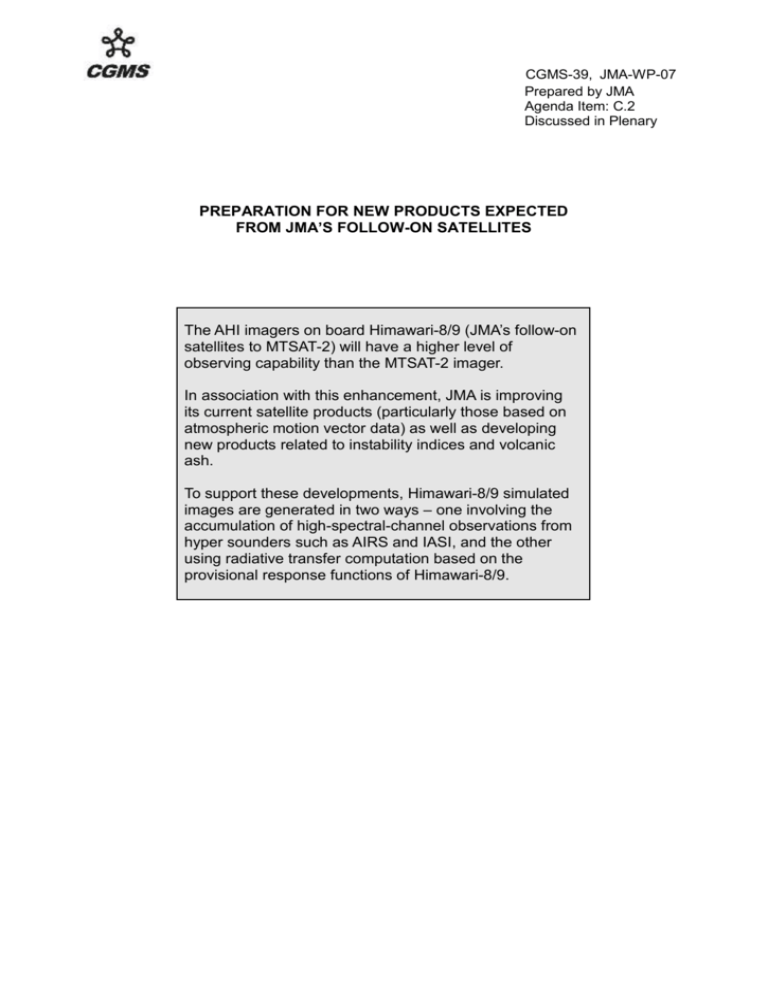
CGMS-39, JMA-WP-07 Prepared by JMA Agenda Item: C.2 Discussed in Plenary PREPARATION FOR NEW PRODUCTS EXPECTED FROM JMA’S FOLLOW-ON SATELLITES The AHI imagers on board Himawari-8/9 (JMA’s follow-on satellites to MTSAT-2) will have a higher level of observing capability than the MTSAT-2 imager. In association with this enhancement, JMA is improving its current satellite products (particularly those based on atmospheric motion vector data) as well as developing new products related to instability indices and volcanic ash. To support these developments, Himawari-8/9 simulated images are generated in two ways – one involving the accumulation of high-spectral-channel observations from hyper sounders such as AIRS and IASI, and the other using radiative transfer computation based on the provisional response functions of Himawari-8/9. CGMS-39, JMA-WP-07 PREPARATION FOR NEW PRODUCTS EXPECTED FROM JMA’S FOLLOW-ON SATELLITES 1 INTRODUCTION The Japan Meteorological Agency (JMA) has selected and defined the functions and specifications of the follow-on observation missions primarily based on user requirements for satellite data and products. To meet these needs, JMA’s follow-on satellites to MTSAT-2 (called Himawari-8 and Himawari-9) will each carry an imager with a capability comparable to that of GOES-R/ABI with the following functions: Multi-channel capacity (16 channels in visible and infrared bands) High spatial resolution (0.5 – 1.0 km for visible and 1 – 2 km for infrared) Fast imaging (within 10 minutes for full disk) Rapid scanning with flexible area selection and scheduling The follow-on satellites will offer high observation potential, which will enable users to analyze cloud properties and cloud physics. To make the most of these functions as well as to provide users with effective information from the start of Himawari-8’s operation, JMA has set up an environment for the development of new products from the follow-on satellites in collaboration with its Meteorological Satellite Center (MSC) and other internal related divisions according to the policies outlined here. In the future, the Agency plans to start the development of related products, and is interested in pursuing scientific and prototyping activities in collaboration with CGMS members. This is particularly the case with EUMETSAT and NOAA/NESDIS, which already operate or are preparing to use a new generation of multi-channel imaging instruments (MSG and GOES-R). 2 IMPROVEMENT OF CURRENT SATELLITE PRODUCTS Enhancement of current satellite products is planned based on the use of fresh observation information from the new imagers on board the follow-on satellites. The products earmarked for improvement are as follows: Atmospheric Motion Vector (AMV) Clear Sky Radiance (CSR) Cloud Grid Information (CGI) Sea Surface Temperature (SST) In particular, significant improvement of the AMV product is foreseen. Higher image resolutions and more frequent observations are expected to provide better target tracking accuracy, and the increased number of imaging bands will enhance AMV height assignment. 3 DEVELOPMENT OF NEW PRODUCTS The enhancement of the observation function of Himawari-8/9 as compared to that of MTSAT-2 is expected to provide a variety of new parameters. To build up new products efficiently against a background of limited research resources, JMA is focusing on the development of two outputs relating to instability indices and volcanic ash. Page 1 of 5 CGMS-39, JMA-WP-07 INSTABILITY INDICES JMA plans to introduce a derivation technique for instability indices, which are operationally used at EUMETSAT and NOAA, and to implement localization for the area around Japan. These indices are expected to support weather forecasters in the early detection of severe meteorological phenomena such as heavy rain and thunderstorms. Instability indices are calculated from atmospheric profiles of temperature and humidity as retrieved using a one-dimensional variational (1D-Var) method based on Himawari-8/9 multi-band observations. The 1D-Var system was developed by JMA’s Numerical Prediction Division. Investigation on the formulation of the indices is currently under way. VOLCANIC ASH The importance of volcanic ash monitoring was highlighted by the April 2010 eruption of Eyjafjallajokull in Iceland and the January 2011 eruption of Shinmoe-dake in western Japan. Volcanic ash directly affects airplane flight plans, and is monitored by JMA’s Tokyo Volcanic Ash Advisory Center (VAAC). Currently, differences between MTSAT 10.8-micron and 12-micron images are used for monitoring the spread of ash. However, quantitative information is also required. From Himawari-8/9 observations, quantitative data such as ash density and height are expected. JMA plans to develop the product based on a EUMETSAT METEOSAT algorithm and a NOAA/NESDIS GOES-R algorithm. The Agency has already started a review of both methods, and will continue related research. 4 PREPARATION OF SIMULATED SATELLITE IMAGES FOR THE DEVELOPMENT OF NEW PRODUCTS The Advanced Himawari Imagers (AHIs) on board Himawari-8/9 will provide images superior to those output by MTSAT. To support the development of Himawari-8/9 products, simulated images are necessary. Himawari-8 and 9 provide 2.5-minute-interval images of the area around Japan as well as 2-km-resolution images in infrared bands. In order to develop the use of this imagery, MTSAT-1R low-level images are used. MTSAT-1R originally has a 2-km-resolution observing capability in infrared bands, and currently performs 5-minute-interval observations of the area around Japan. Simulated images are generated from the two methods and are used to develop the use of Himawari-8/9 16-band images. (A) Images simulated from hyper sounder data Simulated images are generated by accumulating high-spectral-channel observations from MetOp/IASI and other hyper sounders. Such images are useful for the development of products related to volcanic ash/gas, yellow sand, ozone and surface variables, as they originate from actual observations including weather conditions. JMA has conducted a number of experiments (e.g., SO2 detection/total ozone monitoring) in this area and achieved promising results (Figures 1, 2). Page 2 of 5 CGMS-39, JMA-WP-07 Figure 1 Estimation of O3 distribution at 12 UTC on 16 August, 2011, based on simulated infrared channel images of 9.6 μm and 11.2 μm. Simulated images are formed from an accumulation of MetOp/IASI high-spectral-channel observations. Dense ozone is seen in high-latitude areas. Page 3 of 5 CGMS-39, JMA-WP-07 Figure 2 Detection of SO2 at 12 UTC on 26 January, 2011, based on simulated infrared channel images of 8.5 μm, 11.2 μm and 12.3 μm. Simulated images are formed from an accumulation of MetOp/IASI high-spectral-channel observations. Volcanic ash from Shinmoe-dake is shown in orange. (B) Images of radiative transfer simulation Another type of simulated image is generated by radiative transfer computation based on the provisional response functions of the follow-on satellites. For this purpose, data from RSTAR (developed by the laboratory of Dr Nakajima at Tokyo University) are used. For atmospheric fields, analysis and forecasts from JMA’s Numerical Weather Prediction are adopted. To determine surface conditions, a MODIS product released by NASA is used. For atmospheric composition, climate conditions are currently adopted. Figure 3 shows examples of these images. JMA plans ongoing improvement of the related simulation techniques and their utilization in the development of new products. Page 4 of 5 CGMS-39, JMA-WP-07 Figure 3 Radiative transfer simulated images for Himawari-8/9’s 16 AHI bands. The numbers shown in each figure indicate the central wavelength of the bands. Page 5 of 5
